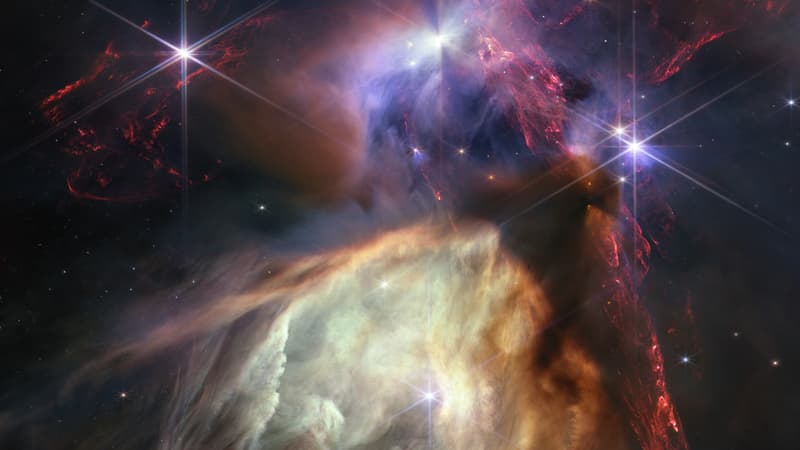A year after the publication of its first snapshots of the cosmos, the James Webb Space Telescope delivered a spectacular new image on Wednesday, capturing the birth of stars similar to our Sun.
Red hydrogen jets dominate the image, caused by nascent stars emerging from their cocoon of dust. It is the closest star-forming region to Earth, at 390 light-years away, located in the Rho Ophiuchi gas cloud.
This image, which contains about 50 young stars about the same size as our Sun, “allows us to see with new clarity a very short period in the life cycle of stars,” said Klaus Pontoppidan, head of the James Webb science program. at the Space Telescope Science Institute. “Our Sun went through a phase like this a long time ago.”
On July 12, 2022, the US space agency released the first color images of its new space observatory. The event marked the beginning of the scientific operations of this jewel of technology, which evolves 1.5 million kilometers from Earth.
“In one year, James Webb has transformed humanity’s view of the cosmos. Each new image is a discovery that encourages scientists to ask and answer questions they couldn’t even dream of before,” enthused the NASA chief, Bill Nelson, in a statement.
For this first anniversary, NASA has planned to remember this year of discoveries during a live video broadcast on the Internet as James Webb continues to dazzle astronomers with images of never-before-achieved precision.
A tool at the service of scientists
He observed the most distant of the galaxies ever detected, supermassive black holes, measured for the first time the temperature of Earth’s “cousin” rocky planets, of which he even began to analyze the atmosphere.
The stream of scientific studies derived from his observations is constant.
One of the telescope’s main missions is to explore the very young universe, only a few hundred million years after the Big Bang. Another great line of research: the study of exoplanets, that is, planets outside the solar system. It should also help to better understand the formation and life cycle of stars.
In addition to these achievements, the general public was able to delight in sumptuous images. In October, James Webb remarkably revealed his first shot of the iconic “Pillars of Creation,” huge structures of gas and dust filled with forming stars, 6,500 light-years from Earth, in our Milky Way galaxy.
The flight of this flying observatory valued at 10,000 million dollars, aboard an Ariane 5 rocket at the end of 2021, had crowned decades of work.
More powerful than its predecessor Hubble
It is the successor to the Hubble Space Telescope, still in operation. Unlike Hubble, which observes the Universe primarily in the visible spectrum, James Webb operates in the infrared. This allows it to detect much weaker lights and therefore see much further.
As this wavelength is imperceptible to human eyes, the images are “translated” into visible colors.
The region captured by the image released on Wednesday is “completely dark when viewed with Hubble,” Klaus Pontoppidan said on Twitter.
James Webb has enough fuel to run for 20 years. Researchers around the world can reserve observing time with the telescope, which is carefully scheduled in one-year increments.
“We have selected an ambitious set of observations for the second year, based on everything we have learned so far,” said Jane Rigby of NASA’s Goddard Space Center. “James Webb’s scientific mission has only just begun.”
Source: BFM TV


